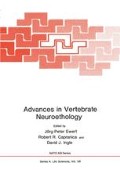Abstract
Animals move through their environment, sometimes just exploring, but more often aiming at a specific goal, such as their next meal. Frequently they will come across obstacles strewn in their path, and to a greater or lesser degree they have developed strategies which enable them to avoid falling into holes or bumping into boulders. Indeed, often they do more than just stop short at such obstacles, they detour economically round them. At times they operate in such familiar surroundings that they have learnt the appropriate path to take when going from one point to another, and there are a number of examples of animals which then continue to make detours long after the barrier which first made the detour necessary has been removed (von Uexküll, 1957).
Access this chapter
Tax calculation will be finalised at checkout
Purchases are for personal use only
Preview
Unable to display preview. Download preview PDF.
References
Collett, T.S., 1982, Do toads plan routes? A study of the detour behaviour of Bufo viridis. J. Comp. Physiol., (in press).
Ewert, J.P., and Gebauer, L., 1973, Größenkonstanzphänomene im Beutefangverhalten der Erdkröte (Bufo bufo L.). J. Comp. Physiol., 85:303–315.
Ingle, D.J., 1971, Prey-catching behaviour of anurans toward moving and stationary objects. Vision Res., (Suppl.) 3:447–456.
Ingle, D., 1976, Spatial vision in anurans, in “The Amphibian Visual System — A Multidisciplinary Approach”, K.V. Fite, ed., Academic Press, New York.
Ingle, D., and Cook, J., 1977, The effect of viewing distance upon size preference of frogs for prey. Vision Res., 17:1009–1013.
Lock, A., and Collett, T., 1979, A toad’s devious approach to its prey: A study of some complex uses of depth vision. J. Comp. Physiol., 131:179–189.
Lock, A., and Collett, T., 1980, The three-dimensional world of a toad. Proc. R. Soc. Lond. B, 206:481–487.
Thomson, J.A., 1980, How do we use visual information to control locomotion? TINS, 3:247–250.
Uexküll, J.v., 1957, A stroll through the worlds of animals and men, in “Instinctive Behaviour”, C.H. Schiller, ed., Methuen Press, London.
Author information
Authors and Affiliations
Editor information
Editors and Affiliations
Rights and permissions
Copyright information
© 1983 Plenum Press, New York
About this chapter
Cite this chapter
Collett, T.S. (1983). Picking a Route: Do Toads Follow Rules or Make Plans?. In: Ewert, JP., Capranica, R.R., Ingle, D.J. (eds) Advances in Vertebrate Neuroethology. NATO Advanced Science Institutes Series, vol 56. Springer, Boston, MA. https://doi.org/10.1007/978-1-4684-4412-4_15
Download citation
DOI: https://doi.org/10.1007/978-1-4684-4412-4_15
Publisher Name: Springer, Boston, MA
Print ISBN: 978-1-4684-4414-8
Online ISBN: 978-1-4684-4412-4
eBook Packages: Springer Book Archive

